Newhall-Potrero Oil Field, Los Angeles County, California
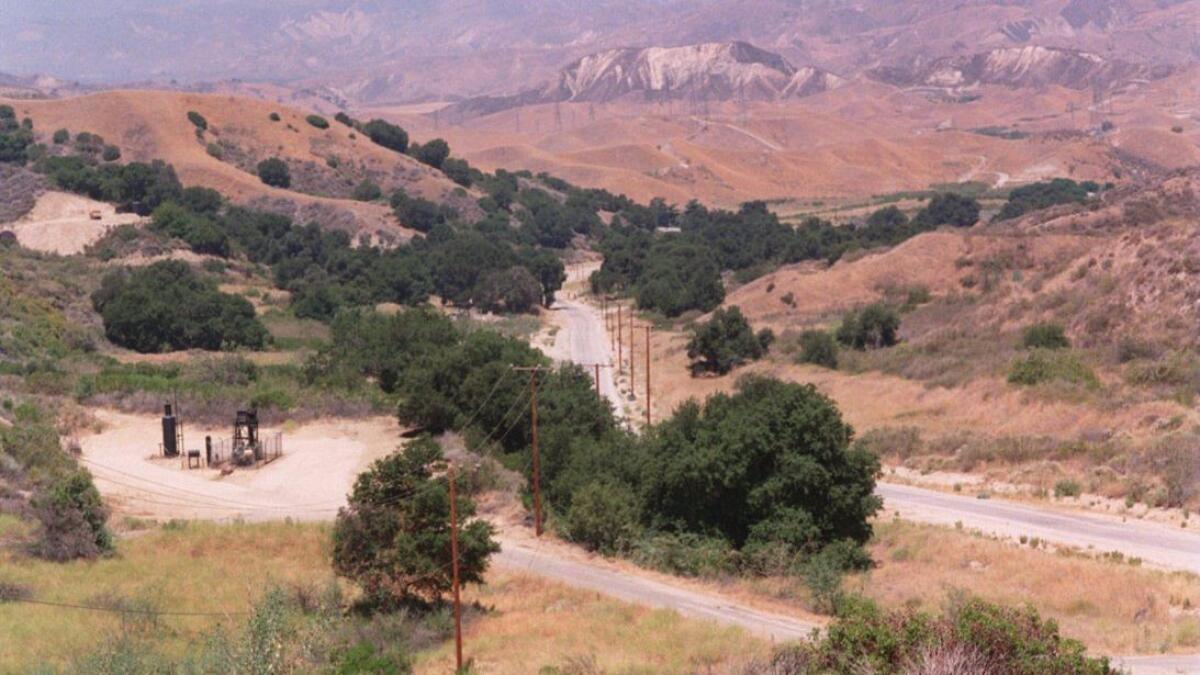
Los Angeles Times, July 18, 2017
Introduction
The Potrero section of Rancho San Francisco is located in the far southwestern part of Los Angeles County adjacent to Ventura County. It was actually called Potrero before 1870 because it is shown on an 1870 survey map (shown below). Just to its south is the famous oil producing field of Pico Canyon. Potrero means pasture or meadow in Spanish, but the section consisted of many rolling hills bisected by a canyon - Potrero Canyon (sometimes called Potrero Valley). Rancho San Francisco was owned by the Newhall Land and Farming Company (NLFC).
Oil had always been suspected to be on the Rancho. Parts of the Newhall Ranch had been leased to many different companies but no oil in commercial quantities had ever been found. Most of the leases had expired without any exploration. Two companies, Union Oil and Associated Oil, had drilled wells to depths of over 5000 feet, but the wells were all "dusters".
In 1899, the NLFC formed the the Newhall Oil and Development Company. The Articles of Incorporation were signed on November 17 by brothers George, Edwin, Henry, and Walter Newhall, along with three other men. They then purchased over 5200 acres of land from the NLFC for $10. The land was on the Rancho mostly just below the Potrero partly in Los Angeles County and partly in Ventura County. See a rough boundary of the property here The company issued a few leases but did no work itself. No oil was found. In 1913, the Newhall Oil and Development Company was dissolved and the land sold back to the NLFC so that they could sell part of the land (2400 acres in Ventura County south of Piru and Camulos) to a French syndicate for $150,000. The purchaser was interested in developing oil wells.
In 1935, Barnsdall Oil Company approached NLFC for the purpose of obtaining an oil lease on the Potrero. We don't really know the reason why Barnsdall wanted the lease, but it was apparently due to the recommendation of their chief geologist Richard W. Sherman (1894-1958). Barnsdall must have had confidence in his judgement because, in 1935, they hired a former big-time corporate lawyer named Patrick Calhoun to negotiate the lease. Calhoun, an acquaintance of Atholl McBean, the president of NLFC, was successful.
On November 4, 1935, Barnsdall obtained a 30-year oil lease from the NLFC in the Potrero section. The lease was signed by Atholl McBean (President) and George A. Newhall (Secretary) for the NLFC. For Barnsdall, the signers were Raymond A. Broomfield (Executive VP) and E.C. Reed (Secretary). The lease was executed for the "uses and purposes of drilling for and producing petroleum oil and gas and other hydrocarbon substances and uses and purposes incidental thereto as herein provided." It covered 933 acres. By 1961, the number of acres had been increased to 1370.
NLFC had little hope that any oil would be found in the Potrero but, because the land was only being used for grazing and a little agriculture, they could use the extra income. The company was still struggling after the collapse of the St. Francis Dam in 1928 (causing much destruction on the rancho near the Santa Clara River) and the Great Depression of the early 1930's. Barnsdall would pay Newhall Land a rental of $933 per year. Royalties to Newhall Land would be 1/8 (12.5%) of all oil and gas produced, reduced by a reasonable amount used during operations. There were many other conditions in the 12-page lease, including provisions for early termination and extension. The lease was recorded in the Los Angeles County Recorder's Office on November 30, 1935.
It wasn't until August 10, 1936, that the first well was spudded. It was appropriately named Rancho San Francisco (or RSF) No. 1. In December, oil sands were reported at 6100 feet, but they kept drilling. The well was completed on March 12, 1937, at 6472 feet. Division of Oil and Gas (DOGGR) records reported that the initial production was 137 barrels a day (1 barrel = 42 gallons) increasing to 142 after 30 days. Other sources had different production numbers. See the complete DOGGR records for RSF 1 here.
As seen above, the Los Angeles Times of March 25, 1937, is the first source calling the new field Newhall-Potrero, although it may not have been officially called that until 1938 based on the Oil & Gas Journal of August 4, 1938 (see below). That journal snippit also explains why the field wasn't just called "Potrero". The older Potrero oil field was named in 1928.
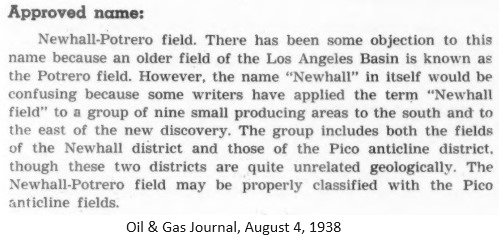
Barnsdall didn't complete the second well until February 6, 1938, nearly a year after completing RSF 1. RSF 2's total depth was 6713 feet with an initial production of 631 barrels a day. RSF 3 was completed on July 7, 1938, at 7364 feet with an initial production of 1603 b/d. RSF 4 was completed on December 17, 1938, at 7353 feet and an initial production of 790 b/d. The future looked bright for the new Newhall-Potrero oil field.
Soon, the Newhall Land and Farming Company gave other companies oil leases nearby. Important new fields would be located in the future including Del Valle in 1940 and Castaic Junction in 1950. Oil royalties became the NLFC's most important source of income.
The Newhall-Potrero oil field became an important California oil and gas field. DOGGR (1991) reported that the peak year of oil production for the Newhall-Potrero oil field was 1955 (at 3.6 million b/d), although there were still some good wells being found after that. For example, in 1957 the initial production of RSF 143 was 713 barrels a day at a well depth of 12,576 feet (dropping to 258 b/d after 19 days). The peak year for gas production was 1963.
There was very little news about the Newhall-Potrero oil field in the 1960's through the 1970's. The Newhall Signal of February 3, 1975, printed a story entitled "Oil Disappears Slowly, Steadily" in Santa Clarita. It stated that the Newhall-Potrero field produced 466,000 barrels of oil in 1975 compared to 790,000 in 1972, so production was decreasing, which is common in most mature oil fields.
Based on CalGem well records, the last well drilled in the field was Rancho San Francisco A1 in 1983.
In March of 1983, Newhall Resources took over the Newhall-Potrero (and Castaic Junction) field. Newhall Resources was spun off from the NLFC evidently created to avoid taxes on dividends. A few years later, in January of 1989, Newhall Resources sold all their assets back to the NLFC.
In 1986, Sun Exploration and Production Company, the current owners of the Rancho San Franciso lease, was one of the largest producers of natural gas in Southern California. However, they were also the 13th worst polluter in Southern California. In the Santa Clarita Valley, they were the worst polluter (see Newhall Signal, January 17, 1988, chart here). Sun believed that the culprite was their natural gas compressing plant so, in 1988, they would spend about $2 million to reduce emissions by at least 64%. Presumably this happened because there were no more news articles about their pollution.
For 1986 oil production, this chart from the Signal of November 8, 1987, shows that production was 301,462 barrels, second to Placerita for Santa Clarita oil fields.
CalGEM (the California Geologic Energy Management Division - formerly the Division of Oil, Gas, and Geothermal Resources) listed 181 oil wells that had been drilled in the Newhall-Potrero oil field. 136 were plugged and 45 were idle (not plugged). The date of the list is no earlier than 1990.
In 1994, with the announcement of the Newhall Ranch housing project, it became clear that the Newhall-Potrero oil field was nearing its end. Over 20,000 homes were planned, with much of the oil field slated to be covered with homes. Unabandoned wells would need to be legally plugged and abandoned. Already abandoned wells would have to be tested for leakage and re-abandoned if necessary. After over 50 years of drilling activity, the oil field would need to be cleaned up to modern standards. However, it would be many, many years before construction would actually begin (see the Newhall Ranch page).
Even with the Newhall Ranch project looming, the Newhall-Potrero field was listed as having the 17th highest oil production in Los Angeles County in 2016. See that list on the Los Angeles Almanac website here. The 2016 production of the field was 68,446 barrels of oil and there were 38 wells still active.
From the well records, it appears that the last wells plugged and abandoned were not until 2021 (at least 17) and 2022 (at least one - RSF 90).
As of July of 2024, no homes have been built in the Potrero Valley section of FivePoint Valencia, the new name of Newhall Ranch, although homes have been built in other sections of the project area. There is no estimate as to when construction will begin in the Potrero, 30 years after the project was first announced.
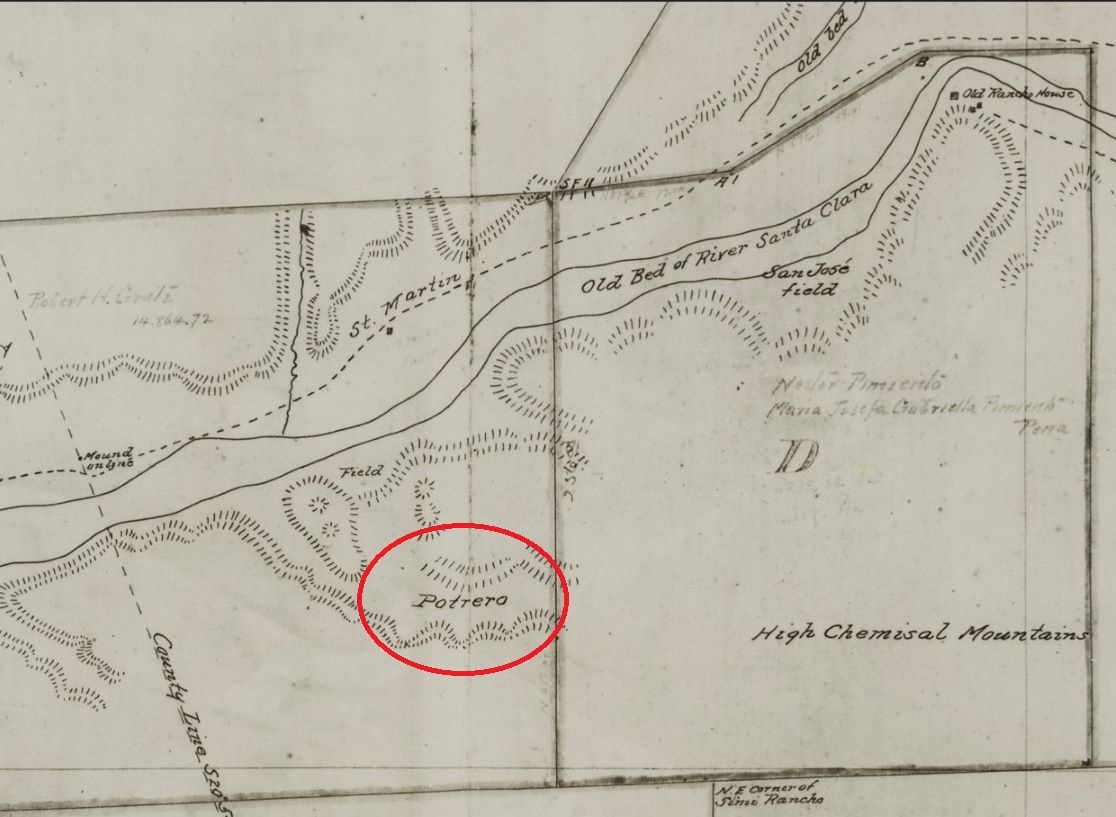
Survey of the Rancho San Francisco filed in 1870 showing the Potrero area (Museum of Ventura County, Collection of Maps). The Ventura/Los Angeles County border is the dashed line on the left. The old location of the Newhall ranch house is on the upper right near Castaic. The ranch house is now at the Santa Clarita Valley History Center in William S. Hart Park near the old train station.
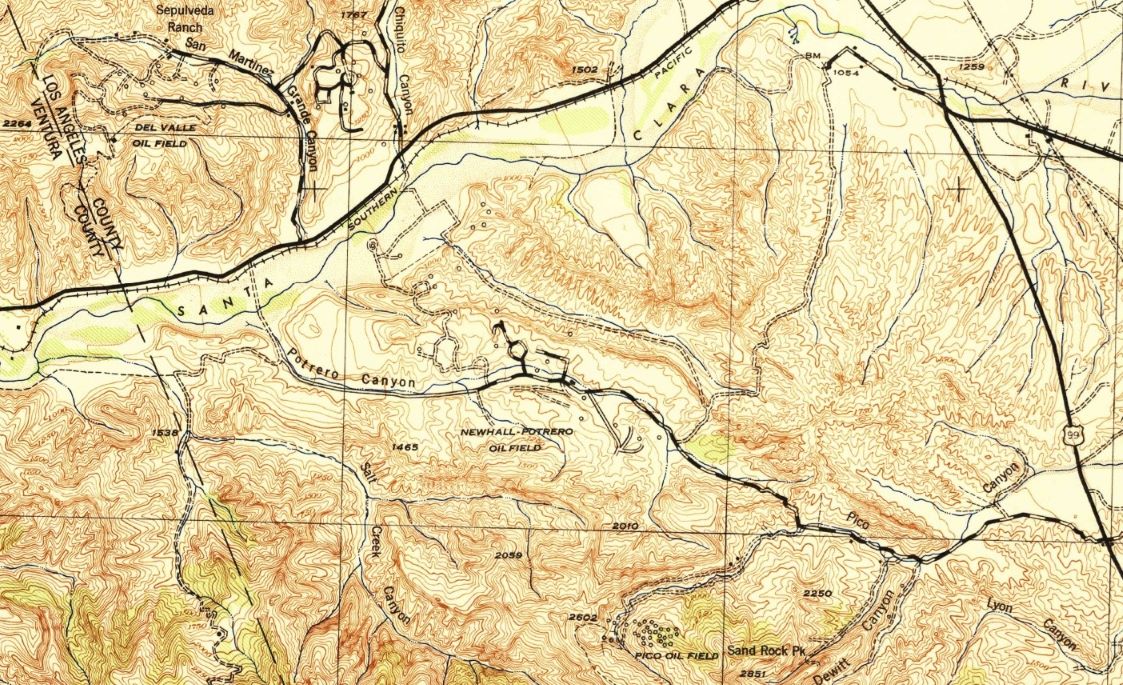
Section of the 1943 Santa Susana topographic map showing Potrero Canyon and the Newhall-Potrero oil field. It is east of the Ventura-Los Angeles County border, north of the Pico oil field, and south of the Santa Clara River. (Santa Susana Quadrangle, 15 Minute Series, War Department, Corps of Engineers, U.S. Army, 1943)
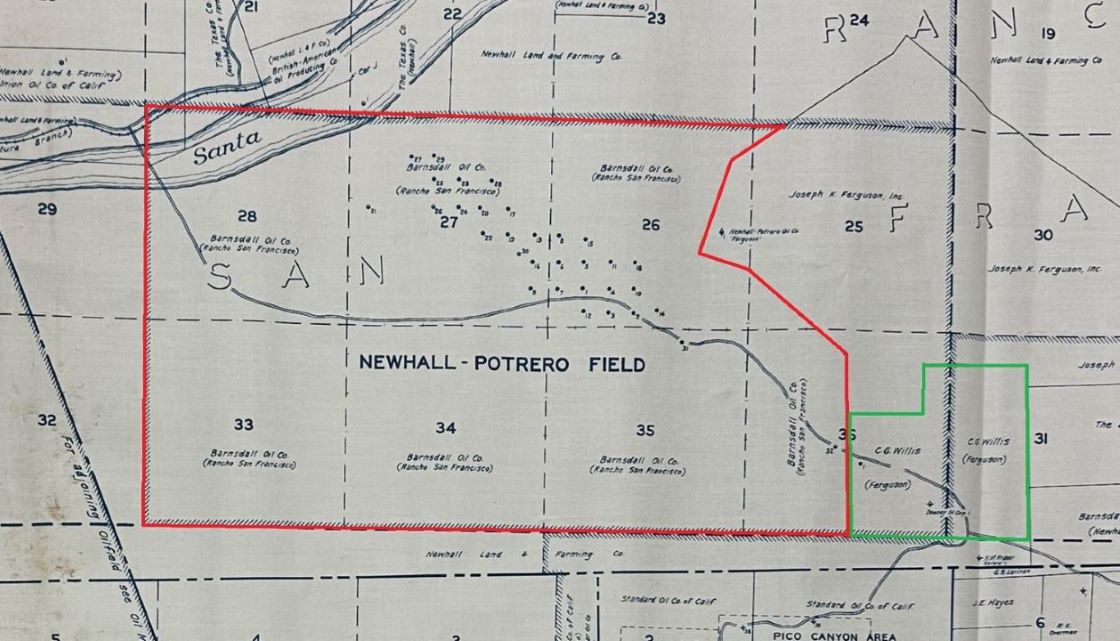
Newhall-Potrero oil field from a 1942 Division of Oil & Gas map. The Barnsdall claim is surrounded with a red line and the Ferguson claim with a green line. The red line probably does not exactly surround the Barnsdall lease, but the actual boundary lines are described by the old metes and bounds system in the lease (which is difficult to follow in the lease). However, this map is how the DOG shows the boundaries, so it is accurate enough for our needs.
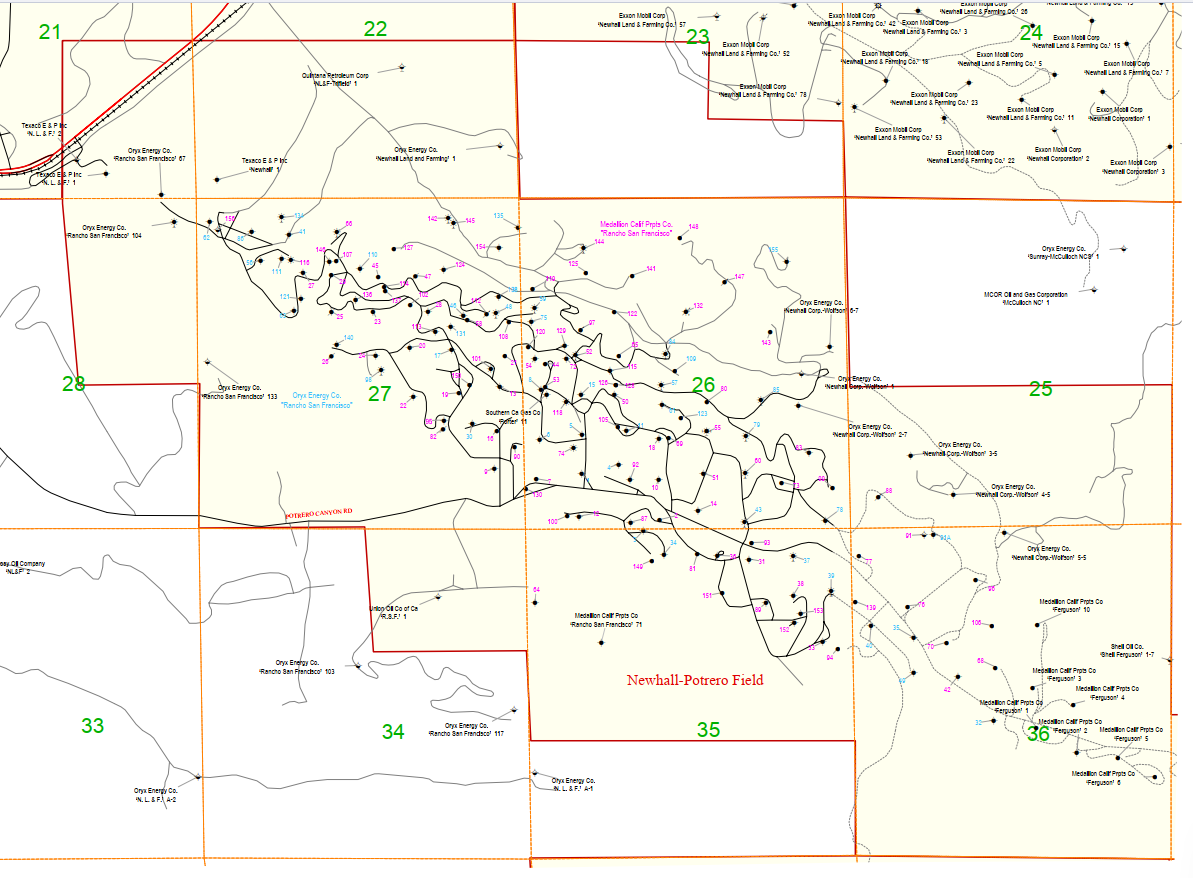
This is a section of Map 253 from the GalGEM (formerly DOGGR) website showing the Newhall-Potrero oil field. The complete Map 253 can be seen here.
Appendix: Rancho San Francisco Lease Ownership History
Through the years the original 1935 lease of the Barnsdall Oil Company from the Newhall Land and Farming Company changed hands many times. The last owner that I could determine (From reading wells records - all ownership changes were supposed to have been reported for each well) was the California Resources Production Corporation. It looks like they obtained the lease in 2018. It's possible that all they did was remediation work on the field. Many of the companies were subsidiaries or owned by other companies, so determining the actual owner (using the internet) was just about impossible. By a legal agreement (see Newhall Ranch page), the lease was due to expire in 2020. As far as I can tell, all the wells in the Newhall-Potrero field were properly plugged and abandoned by 2022.
1935: Barnsdall Oil Co. obtained lease from NLFC
1950: Barnsdall Oil Co. merged with Sunray Oil Corp.
1955: Sunray Oil Co. merged with Mid-Continent Oil Co. and became the Sunray Mid-Continent Oil Co.
1962: Sunray Mid-Continent Oil Co. name change to Sunray DX Oil Co.
1968: Sunray DX Oil Co. merged with Sun Oil Co (and became the DX Division)
1982: Sun Oil Co. name change to Sun Exploration and Production Co.
1989: Sun Exploration and Production Co. name change to Oryx Energy Co.
1991: Oryx Energy Co. to Tidelands Oil Production Co.
1992: Tidelands Oil Production Co. to DKM Offshore Energy Inc.
1994: DKM Offshore Energy Inc. became Medallion California Properties Co. (which was acquired by KCS Energy in 1999)
2006: Medallion California Properties Co. to Vintage California Production LLC (subsidiary of Occidental Petroleum Corp.)
2018(?): Vintage California Production LLC to California Resources Production Corp.






